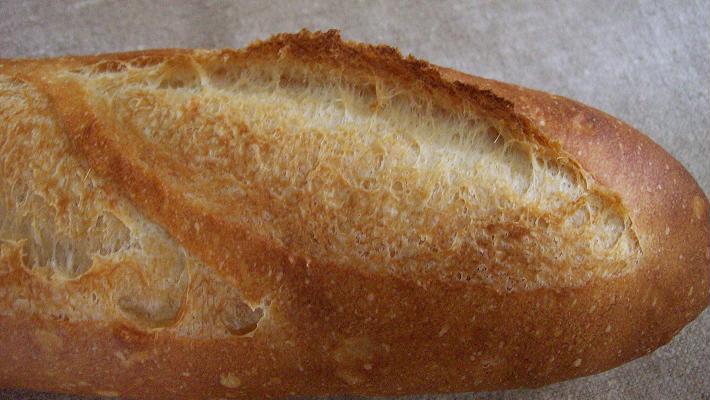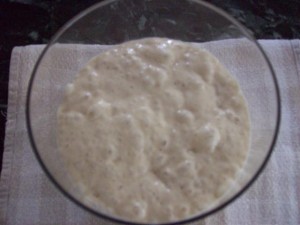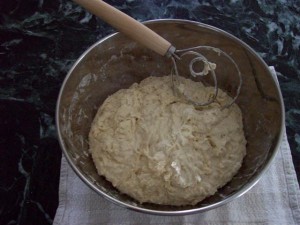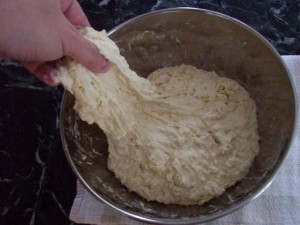Baguettes with Poolish
Jun 28th, 2008 by SteveB
It’s been said that the baguette, although�one of the simplest breads (being comprised of only�flour, water, yeast and salt), is perhaps the most difficult bread to make well. A good baguette has a thin, crisp crust, a light and airy crumb having a distribution of both large and small air pockets (alveoli), and a slightly sweet, almost nutty flavor. Being the perfectionist that I am, I would also add that a good baguette has to look enticing, being a feast for the eyes as well as the stomach.

The baguette formula used here is a modification of the Baguettes with Poolish formula described by Hamelman on page 101 of�Bread: A Baker�s Book of Techniques and Recipes (see book for baker’s percentages).� The main changes were in the method of mixing (see�Musings on Mixing�), the amount of yeast used in the final dough and the elimination of the folding step.
Poolish
- 10.6 oz. King Arthur All-Purpose Flour
- 10.6 oz. Water
- 1/8 tsp.�Instant Yeast
Final Dough
- 1 lb., 5.4 oz. King Arthur All-Purpose Flour
- 10.6 oz. Water
- 0.6 oz. Salt
- 1 tsp. Instant Yeast
- 1 lb., 5.2 oz. (all of the above) Poolish
Prepare the poolish the night before baking.� Mix the flour, water and yeast together until the mixture is�the consistency of a smooth, thick batter.� Cover�and let it ferment overnight at a temperature of around 72oF until mature (about 12 hrs).

The next morning, prepare the final dough by combining the flour, yeast, salt, water and poolish, just until all the ingredients are mixed and well hydrated (I find a dough whisk to be particularly suited to this task). The water should be at a temperature which will give a final dough temperature of around 76oF (more on this in a later post).� I also used less yeast than the Hamelman formula calls for because of the high�temperature of my kitchen at this time of year (the higher temperature would shorten the first fermentation time, and hence compromise the flavor,�if the quantity of yeast was not reduced).��Depending upon your conditions, you may need a bit more or less yeast.


After the ingredients have been fully incorporated, the dough is mixed by hand (see Musings on Mixing…) for about 10-15 min., until the dough develops a smooth skin which doesn’t tear while mixing. The dough is then placed in a lightly oiled, covered container and allowed to ferment.� This first fermentation is judged complete when the imprint of a finger poked into the dough remains.� In this particular case, the first fermentation lasted 1 1/2�hours.� In addition, the dough was judged to have developed sufficient strength after�the hand mixing so that the�folding step during the first fermentation suggested by Hamelman�was not needed.
Once the first fermentation was judged complete, the dough was divided into 4 equal pieces, by weight, and each piece was given a gentle round pre-shaping.� The dough pieces were then covered with plastic and allowed to rest for 20 min.��After the rest, each dough piece was�shaped into a baguette and then nestled within the folds of a linen couche, as�shown below:[qt:http://breadcetera.com/wp-content/uploads/2008/06/BaguetteMaking2.MOV 500 375]
The shaped�baguette dough is�then covered with the remaining linen and allowed a second fermentation time of about 1 hr.� The second fermentation is judged complete when a finger press results in an impression that lasts for 2-3 secs.
After the second fermentation is complete, the baguettes are scored with a lame and baked in a 450oF oven for 20 min., with steam being supplied during the first 10 mins. via a hand steamer and an inverted buffet tray with a small hole drilled into it (details of the steaming technique are described here):


Interestingly I have read that baguettes produced in Paris baked under strict regulations. Corn meal may not be used only flour in any of the baking procedures, only flour. The hours that they can be baked and sold are regulated as well.
Hi Elaine,
It seems as if you might have left out a pound of flour from the final dough. The quantity of flour in the final dough is 1 lb., 5.4 oz., not just 5.4 oz. It’s no wonder your final dough turned out runny. 🙂
Hi Steve,
I am from Asia and I really blessed to find out your blog on bread baking. I have tried out 8 types of your bread recipes and my hubby and kids love it. I love your ciabatta bread, the most beautiful bread that I ever seen. I baked it once and it turned out good to me (I don’t have any baking stone and pizza peel.) Well, in order to know whether I am on the right track, I wish I can share my picture of my bread to you. I don’t have any blog spot. Thank you.
Hi Leannah,
I’m glad to hear that you and your family are enjoying your home-baked bread!
Unfortunately, readers of Bread cetera aren’t able to upload photos of their bread to the site. However, there are a number of other sites, such as Flickr or SmugMug, that allow people to upload photos so that others may see them.
hola hace tiempo andaba buscando una receta para hacer el pan frances y la encontre en este blog esta muy buena su receta pero no entiendo las cantidades en onzas me podria enviar los ingredientes en gramos por favor sobre todo los pesos de las harinas tanto en el poolish como la masa final para ver si me queda igual o parecido al suyo y en cuanto al horneado se le coloca la bandeja encima al pan para generar vapor y la bandeja en el piso del horno con agua el horno mio es normal no es de convencion
gracias muy amable nancy.
Hola Nancy,
To convert from ounces to grams, multiply by 28.3. For example, the 10.6 ounces of flour used to make the poolish is the equivalent of 10.6 x 28.3 = 300 grams of flour.
Hi
Thanks for sharing.
I read thru comments here before I start making bread. You mentioned watch the video, but I haven’t found the video you mention. Is it removed and no longer exist? Thanks
Also quick question.
I have a bread machine. Can I use it inteads? Since my hand is hurt and weak. Thanks
Hi Candice,
I’m not sure of the video to which you are referring, but all the videos on this site can be accessed by clicking on the ‘Videos’ tab at the very top of each page. While I’m not a big fan of bread machines, they do serve a valuable purpose for those people who have difficulty working with their hands. Why not give it a try? 🙂
Thanks for getting back.
Hahahaa…I have no idea which video. Saw ur reply and some ppl s comments mentioned ” watch video help a lot”. like #5 comment
And you # 40???u mentioned watch the video HERE, but click on here…there was nothing
I m just curious maybe the video shows how make baguette bread?
I m beginner..want to learn how to make it.
I only make sweet buns with tang zong before…this is too easy…lol
Thanks
Candice,
In order to view the videos, you must have QuickTime installed on your computer. QuickTime can be downloaded here.
Thanks so much Steve
hola steveb quisiera saber donde se consigue la steam baker que no he podido entrar a la pagina por donde mas se entra otra pagina gracias
o ya no la venden
gracias nancy
Hola Nancy,
If I understand your question correctly (unfortunately, I don’t speak Spanish), any hand-held steamer with a pointed tip will do (for example, see http://tinyurl.com/n67hoav).